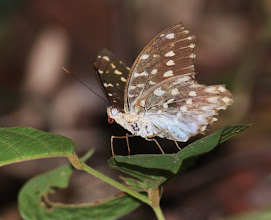In June I visited a place which I have not been in many years. It is located at the far end of the state of Kedah, in a place called Baling. There were many visitors at that time so I headed to a few trails which have less humans and cars. There were at least 5 - 6 trails at this site and you might take more than one day to cover them all. I heard a few Trogons calling but surprisingly less butterfly varieties. Perhaps the food plants like Leea indica and Lantanas are not flowering then.
Malayan Birdwing
(Troides amphrysus ruficollis)
This is a male. There were a few of them flying around at different trails which means this could be a conducive mating and breeding habitat for this species.
Wax Dart
(Cupitha pureea)
There were already sightings by other spotters in two different states just a few weeks before this.
Little Map
(Cyrestis themire themire)
I have not come across any photos which show a protrusion / extension such as this on this species.
Little Map
(Cyrestis themire themire)
As mentioned by Dr Kirton in his field guide, this species likes to hang upside down under a leaf.
Common Faun
(Faunis canens arcesilas)
Always at ground level and loves to 'eat' rotten fruits.
Common Faun
(Faunis canens arcesilas)
This fella here is its close relative
(Faunis gracilis)
(Ypthma horsfieldii humei)
First time seeing a jagged looking HW
A much smaller and lesser known Lexias.
Lexias canenscens pardalina
Yellow Archduke
(Mooreana trichoneura trichoneura)
A moderately uncommon flat.
Blue Brilliant
(Simiskina phalia potina)
This is a female
Dark Posy
(Drupadia thedia thesmia f minara)
Plush
(Sithon nedymond nedymond)
Male
Dull White Palmer
(Acerbas martini)
This should be an uncommon skipper
Dull White Palmer
(Acerbas martini)
It was very skittish as it gave me only three shots - two was fine and one was blur.
Green Oakblue
(Arhopala eumolphus maxwelli)
Only seen this Oakblue three times in my life so far.
Common Disc Oakblue
(Arhopala epimuta epiala)
A localised and just a moderately common Oakblue. The faint white cilia can be seen here.
Banded Yeoman
(Cirrochroa orissa orissa)
Common but looks nice in the sun.
Clavate Banded Demon
(Notocrypta clavata clavata)
Banded Red Forester
(Lethe minerva minerva)
My lifer in June ! Very skittish - at first it flew away from me at first sight. Then luckily it came back.
Malayan Batwing
(Atrophaneura nox erebus)
According to Dr Kirton, Malayan Batwing is similar to a Common Batwing (A. varuna) except that A. nox has rounder forewings and is red only at the tip of its abdomen which both features can be seen here.
Angled Cylops
(Erites angularis angularis)
Most Cylops are deep forest species and hardly common.
Red Bush Brown
(Mycalesis oroatis ustulata)
My 1st lifer. Although reportedly common but I guess it's quite localised.
Malayan White Flat
(Seseria affinis kirmana)
This is a uncommon species. My 2nd lifer.
Malayan White Flat
(Seseria affinis kirmana)
A fast flyer and quite skittish.
Gem Demon
(Ancistroides gemmifer)
This is just a moderately common skipper.
The Constable
(Dirchorragia nesimachus)
A rare and beautiful butterfly. Only my 2nd time seeing it.
A mega species with a beauty to behold.
The big ones came marching in. Here's the first one.
Tawny Rajah
(Charaxes bernardus crepax)
This looks very different than its usual orange-brown underside.
Another big one.
Jewelled Nawab
(Polyura delphis concha)
Red Helen
(Papilio helenus helenus)
Red Helens are quite common - only inside the forest but not at its fringes.
Lesser Cruiser
(Vindula dejone erotella)
de niceville's Oakblue
(Arhopala agrata)
This is one of those few Oakblues which I am able to identify.
White-dot Oakblue
(Arhopala democritus lycaenaria)
Light Straw Ace Dark Banded Ace (Pithauria stramineipennis) (Halpe ormenes)
Plain Yellow Lancer
(Xanthoneura corissa)
One of the ways to differentiate it from a Matapa aria (Common Redeye) is from the yellow patch at its lower antenna which does not show on a Matapa aria.
Common Jester
(Symbrenthia lilaea luciana)
A two in one shot !
Malayan Red Harlequin (Paralaxita damajanti) - behind
and Red Harlequin (Paralaxita telesia) - front
Malayan Red Harlequin
(Paralaxita damajanti)
Red Harlequin
(Paralaxita telesia lyclene)
Pointed Palmfly
(Elymnias penanga penanga)
I end this month's post with this skipper which you might not have seen it having such a vibrant colours.
Red Demon
(Ancistroides armatus armatus)
This is a deep forest skipper. Hardly venture out in the open or even near a trail. It is slightly larger than a Chocolate Demon (Ancistroides nigrita).
It stayed quite close to the ground underneath a thick foliage.
THE END FOR THE MONTH OF JUNE 2024


















































No comments:
Post a Comment